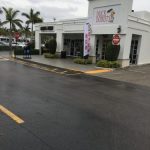Though yield difference between the 100 and 50% irrigation levels was significant, added costs for applying irrigation were incurred. The main reason is that the production cost per ton and the partial net returns to irrigation between the two irrigation rates were very close because the additional per hectare revenue in the 100% irrigated napier grass was basically negated by the additional irrigation application cost compared to the 50% irrigated napier grass. Irrigation and nitrogen and potassium fertilizers were removed from the cost estimates and replaced by actual amounts used in the study. For a long time, naturally cultivated farming can save 8 years of good yield and protein level. Cinc. The non-irrigated napier grass competitive price was lower than each of the irrigated rates at $77.40 and $93.78Mg1 (Table 5). Economic Competitiveness of Napier Grass in Irrigated and Non-irrigated Georgia Coastal Plain Cropping Systems, https://doi.org/10.1007/s12155-018-9916-1, Agronomic performance, nitrogen acquisition and water-use efficiency of the perennial grain crop Thinopyrum intermedium in a monoculture and intercropped with alfalfa in Scandinavia, Perennial Bioenergy Crop Yield and Quality Response to Nitrogen Fertilization, Alley Cropping System in Degraded Land of Central India: Evaluation of Crop Performance, Economic Benefit and Soil Nutrients Availability, Conservation Agriculture-based Sustainable Intensification of Cereal Systems Leads to Energy Conservation, Higher Productivity and Farm Profitability, Cover crops for weed suppression in organic vegetable systems in semiarid subtropical Texas, Herbage accumulation, nutritive value and beef cattle production on marandu palisadegrass pastures in integrated systems, Green Manuring for Low-input Irrigated Maize Cultivation as an Energy Crop in Mediterranean Climates, Mulching and nitrogen management in peanut cultivation: an evaluation of productivity, energy trade-off, carbon footprint and profitability, Utilisation of cover crops: implications for conservation agriculture systems in a mediterranean climate region of South Africa, https://doi.org/10.1094/CM-2011-0721-02-RS. Bioenerg. The Napier grass leaves and shoots which are young are considered edible and they are also used to make stews and even soups. Napier grass contains 30.9% total . Peanuts were dug and inverted using a 2-row inverter and allowed to cure in the field to approximately 18% moisture content. These costs were removed to accurately depict the actual cost. Don't cut the fully grown plants directly on the level of the surface at the time of harvesting. Napier grass is used in the pest management strategy as a pull crop which attracts the pests to come out of the plant. Cotton varieties also varied consisting of PHY375WRF (2011 and 2012) and PHY499WFR (2013, 2014, and 2015) (Dow AgroSciences, Indianapolis, IN). Excess green feed can be preserved in the form of silage. These cuttings can be 15 to 20 cm long and white-yellowish by color. 8:134141, Lamb M, Sorensen R, Nuti RC, Butts CL, Faircloth WH, Eigenberg D, Rowland DL (2011) Agronomic and economic effect of irrigation rate in corn produced in Georgia. Cross commodity breakeven prices are also calculated within WholeFarm [16]. At the top end of the range, napier grasses have been shown to yield up to 80 dry tonnes per hectare per year, . The results indicate that under recent crop prices and production levels, napier grass will not compete against traditional irrigated cropping systems. Combined fertilizer treatment yield effects in napier grass for N and K fertilizers were not significant and are removed from the statistical model for yield to achieve greater replication (Table 2). The main reason is the significant cost of N at the application rates used in this study. Cross commodity breakeven prices provide the prices change required such that the net returns between crops are equal. After harvest, samples were further cured to around 9% moisture, weighed, and riffle divided to obtain a 1800g sent to the Alabama Federal State Inspection Service (Dothan, AL) to obtain peanut grade factors including foreign material, total sound mature kernels, sound splits, other kernels, loose shelled kernels, and damage kernels. Merkeron napier grass (Pennisetum purpureum) plots were established in 2010 and harvested during crop years 2011 through 2015 adjacent to an on-going peanut (Arachis hypogaea L.), corn (Zea mays L.), and cotton (Gossypium hirsutum L.) cropping systems study conducted at the USDA/ARS Multi-crop Irrigation Research Farm in Shellman, GA (84 36 W, 30 44 N) on a Greenville fine sandy loam (fine, kaolinitic, thermic Rhodic Kandiudults). Irrigated yield were comparable to reported dry biomass yields of 16.4Mgha1 across five energy cane varieties with yield converted to a total farm area basis in Louisiana [4]. Unlike Berseem fodder, Super Napier grass grows by cutting nodes. Although the yield difference comparing the 100% and the 50% irrigation rate was much less at 8% (2281kgha1), significant differences resulted. Your email address will not be published. The breakeven prices are calculated for total costs (variable and fixed costs) for all crops. Amer. The decision criteria for adoption of napier grass (or any crop enterprise) into existing cropping systems will depend on comparative profitability and risks. Super Napier grass which is scientifically a cross of Napier grass (Pennisetum purpureum) and Pearl millet (Pennisetum glaucum). Net returns were most influenced by irrigation, crop rotation sequence, and commodity price. Just beside horns, Gir cow ears rest downwards. Irrigated peanut, cotton, and corn yields were increased 52, 93, and 297% over the non-irrigated yield (P0.05) during the 20112015 crop years (Table 2). Poultry farm business plan 2022 In an integrated farming system poultry farming is one of the major parts of the business model, which is helpful to solve problems of farmers. Peanut Sci 37:100105, Nuti RC, Lamb MC, Sorensen RB, Truman CC (2009) Agronomic and economic response to furrow diking in irrigated and non-irrigated cotton (Gossypium hirsutum L.). Thus, production cost estimates were derived from two studies conducted in the Southeast USA which cost estimates for energy cane were adapted from previous research in sugarcane. . Merkeron was released by the University of Georgia in 1989 with improved yield potential and disease resistance and selected for this research because of the yield potential shown across irrigated and non-irrigated production regimes [9]. The model is designed to avoid crop stress while triggering irrigation at the most efficient timing and volume to avoid over-irrigation. Each and every seedling has to be separated from the clump. Google Scholar, Alvarez, J. and Z.R. Because the food (fodder) is a mixture of poisonous, feeding livestock that causes death. China raise the maximum number of chickens in the world for meat. Part of Springer Nature. Total rainfall received and irrigation applied during the growing season for each crop is provided in Table 3. Educ. First of all, one of the major sections of Super Napier grass cultivation is the prepared land. Breakeven prices (cost per acre divided by yield) provide the prices at which production costs are covered for the given yield. The reproduction of Napier grass is done in a vegetative way through shoots which are horizontal called stolon which locate above the soil extending from the parent to the offspring. Understanding the costs and the potential economic returns to bioenergy alternatives are prerequisite components to adoption. However, when analyzed across all K application rates, N did have a significant effect on napier grass yield (P=0.0185). Generally, Napier grass can grow between 10 to 33 degrees Celcius, but more or less temperature affects their growth including a sudden change in seasonal conditions. Peanut, corn, and cotton were produced in non-irrigated and full irrigation regimes. Economic analysis of napier grass production in riparian buffer zones and non-cropped areas will be addressed in the future. Focusing on variable costs only is a more direct and comparable approach when evaluating inclusion of a new crop alternative into an existing cropping system. Napier grass can grow in a large variety of soils. Because its fragrance on the surface of the leaves hesitates cattle to eat the fodders. The remaining 50 percent of the nitrogen should be applied on the 30th day of planting. Napier grass had lower global warming (GW) impacts and biomass delivery costs, 34-153 kg CO eq. Napier grass does not grow properly in the areas where there is waterlogging. Following 90 days to reach maturity, farmers get 20 tonnes per acre when wet, or 10 tonnes of dry matter. The plantation of Napier grass is done in the marginal slopes and lands in order to improve the fertility of the soil and to decrease the erosion of soil. Bioenerg Res 7:609619, Article Some people can't distinguish between Jersey and hf cows. per oven-dry metric ton (ODMT) and $51-$57 perODMT, respectively than that of energy cane. Cane cuttings are placed at an angle of 450 inside the planting holes. This is because, late sowing gives only one cut by the last week of November and after that, it stays in a dormant stage. The distance between the rows of the pits should be 60 centimetres. Economic feasibility of biofuel crops in Florida: energycane on mineral soils. Super Napier grass yield per acre. Can be grown for commercial hay production. Lamb, M.C., Anderson, W.F., Strickland, T.C. The breakeven prices in the 100 and 50% irrigation levels were basically the same at approximately $69 and $90 per ton for variable and total cost (Table 5). Using iron plought, two to five feet deep or about 15 to 30 cm ploughing should be done deeply. Napier grass is one of the important perennial tropical forage crop belong to family Poaceae. EDIS document SC089, Anderson WF, Dien BS, Brandon SK, Peterson JD (2008) Assessment of bermudagrass and bunch grasses as feedstocks for conversion to ethanol. The net return to irrigation in the 100% irrigation level did not differ from the 50% irrigation level and net returns to both irrigation levels were higher than the non-irrigated level. One tim, Some people get suddenly excited by hearing the thumbnail or profit margin that people claim in hydroponic farming. On a dry matter basis, breakeven napier grass prices at variable cost ranged from $65 to $69Mg1 depending on irrigation regime and fertility treatments and breakeven prices at total cost ranged from $84 to $91Mg1. After each harvest, 30 kg of nitrogen (65 kg of urea) will be given higher yield. The following will help you to get an idea of investment and setup cost(initial and per cycle) in hydroponic farming. Bioenerg. BioEnergy Res 5:206214, Article 2009 demonstrated the importance of yield on breakeven prices for switchgrass produced on four differing soil types in Tennessee with breakeven prices ranging from $46Mg1 (17.7Mgha1 yield) to $69Mg1 (8.5Mgha1 yield) concluding that breakeven prices were influenced by yield, N price, and fuel prices [19]. . Google Scholar, Knoll JE, Anderson WF, Malik R, Hubbard RK, Strickland TC (2013) Production of Napier grass for bioenergy under organic versus inorganic fertilization in the Southeast USA. Peanuts contributed the highest influence to net returns followed by cotton and lastly corn within the cropping system [21]. It produces more tillers with soft and juicy stem, free from pest and diseases and non-lodging. Plantation of many numbers of rows maintaining a space of at least 3 feet should be done in between the rows. Agronomic and economic effect of irrigation rate in cotton. Data on production costs of napier grass, sugarcane, or energycane in the coastal plain region of Georgia are not available. Merkeron) was established in 10-cm pots in the greenhouse for transplanting the following spring. The soil should be Extinguishing once in 150 days. The shoot become hard and flowers prematurely. Available at http://www.nass.usda.gov (accessed 10 October 2016). As long as there is continuous chemical use, decreases life expectancy and decreases yield and protein levels. Using a similar approach and assumptions, a study in Florida concluded that the total variable costs of production for energy cane was $1836ha1 with fixed costs of $309ha1 [5]. Per industry standards, final pod weight was obtained after grading by deducting foreign mature and adjusting to 7% moisture content for determining final yield. For the plantation of Napier grass, there are two methods used: In this method, you need to first dig the field up to 20 centimetres wide and 20 centimetres deep by maintaining a distance of up to 90 centimetres in between the rows and a distance of 60 centimetres between the plants. Napier plant with smutted tillers (initial symptom). Investment in 1000 Super napier grass plants. They sow as a plant to plant distance should be 2 feet and row to row distance should be 2 feet. Napier grass stunt diseased growth from cut clumps, Stunt disease infected plant and the plant hopper that transmits the disease. If the price received for peanuts is greater than the breakeven then peanuts are more profitable. How many times do people talk about desi cows for the dairy farming business? Co.CN4 is a recent hybrid Napier grass released by TNAU, Coimbatore, which is a cross between Cumbu Co.8 and Napier grass F.T.461. GCB Bioenergy 8:11621177. 8 harvests per annum. Corn was planted at 6.5 seeds m1. After this, watering should be done immediately. . The combined fertility treatments did not have an effect on napier grass yield (P=0.054). The buds of the cuttings should face up and should not be damaged. Directly estimating the farm level returns of napier grass as a bioenergy feedstock is limited by the absence of price data for dry matter napier grass. BioEnergy Res 6(2):110, Mark TB, Salassi ME, Deliberto MA (2009) Developing a cellulosic ethanol industry in Louisiana. For non-irrigated practices, the required breakeven price for peanuts was not reached during the 5-year period and twice during the 10-year period (Table 6). Super Napier grass is a highly nutritious forage crop in many parts of the world. The pits length can change and it is completely dependent on the land which is available. This is the method which gives very high yields of herbage even in the seasons which are dry. Concerns related to reducing productive cropland for the production of biofuels are warranted and will continue into the future. One is Round pit and the other is a rectangular pit. Cost of production estimates for peanut, corn, and cotton were taken from the University of Georgia Crop Extension budgets for non-irrigated and irrigated production. Differences in napier grass yield resulted between the irrigation rates and the non-irrigated yield (Table 3). Gir cow milk and Ghee quality is very unique and high, feeding and caring are very affordable and easy to manage even in a small budget. After the sowing process gets completed, the first irrigation does just by showering water on the soil. With the grass yielding about 600 bales per acre in one season and you can harvest 4 times in an year.The 2400 bales of Brachiaria grass can generate about 720000 .A bale of Brachiaria grass is more expensive than boma Rhodes and sells at 400.Brachial gives 20 tonnes of green fodder per acre. The soil should be fully absorbed and given the required nutrients then the soil should be extinguished. Save my name, email, and website in this browser for the next time I comment. However, net returns associated with higher irrigation and nitrogen levels were basically the same because of the added costs. Potassium rate across all N rates did not have a significant effect on napier grass yield (P=0.7127). Super Napier Grass price per kg. The rainfall received in 2013 is the primary reason the napier grass lodged and complicated harvest. Napier grass yield increases were associated with higher N rates varied with irrigation levels (Table 4). Resulting from objective 2 will be cross commodity breakeven prices for each crop such that returns per acre are equal providing price points at which napier grass is economically competitive to the cropping system as well as crops with the system. Green fodder yield of 100 tonnes per year is obtained from one hectare. You can convert Poultry farming into sustainable poultry farm too. Then remove the stems of Napier grass which are at the ground level in order to remove the green material. As a result, significantly less irrigation was applied in 2013 for all crops. 1. 1. It has high crisp leaves. Stalker, (eds.). The disease need more attention since there is risk of spreading to other African countries. The infected plants typically have small yellow leaves and short internodes. Watering should be done on the third day. Links will be auto-linked. Variable costs for non-irrigated peanuts, corn, and cotton were $1323, $724, and $1006ha1 and fixed costs were $469, $237, and $470ha1, respectively. However, estimates of napier grass yields and cost of production coupled with complete return analysis for peanut, corn, and cotton allow estimation of the price required for napier grass to equal profitability to other crops and the peanut, cotton, corn cropping system. Although the establishment of Napier grass is labour intensive, planting three-node cuttings will ensure high survival rates, sustained high dry matter production and a high number of Napier grass planting material (Table 3). Peanut Res. Wet soil is preferred at the roots but you need to make sure that it is not stagnated. Each plot consisted of three rows 10m long (2m between rows) with 9 plants within each row. Farmers should, therefore, continue to establish Napier grass using the current recommended size of three-node cuttings. Super Napier grass grows by cuttings of at least 2 nodes( mentioned above). To give 60 kg of nitrogen (130 kg urea), 20 kg of phosphate (125 kg super of phosphate) and 16 kg of ash (27 kg of potassium). The water level of irrigation water must not be above the middle section of the plants. 2023 Springer Nature Switzerland AG. Producers should also consider the implications of the multi-year commitment of perennial crop production relative to the flexibility of altering annual cropping sequences as factors influencing net returns change. After that, Super Napier grass will grow very fast and densely. Jersey cow eyes color is black but, Once there was a time when local desi Indian cow breeds produced a high milk yield. Fertilizer treatments were applied in April of each year over the entire three row plot. Total rainfall received was fairly consistent in all years for all crops with the exception of 2013. Although yield increases were associated with increasing N rates in the irrigated regimes, partial budget analysis for N rates showed no difference in net returns to N rates (P=0.4217). Anyone you share the following link with will be able to read this content: Sorry, a shareable link is not currently available for this article. Organic Farming : Myths and Facts Read or Miss Out, Farming System: Definition And Types Of Farming System, Insight On Cultivation Of Rice: From Sowing To Harvesting. Now, use soil in order to cover the roots. Irrigated and non-irrigated land charges of $337 and $90 per acre to reflect regional rates were included for peanut, corn, cotton, and napier grass. Principal purpose of chicken farm is to raise chickens for meat. Then place a cane which has 3 nodes at a slanted position in the soil by making sure that the two of the nodes are covered with soil. Plots were 15.2M and harvested using a 2-row pull type peanut thresher with a bagging attachment. Merkeron napier grass plots were established in 2010 and harvested during crop years 2011 through 2015 adjacent to an on-going peanut, corn, and cotton cropping systems study. Wastewater can also be used for irrigation. Later it starts to decrease and stop to 30 liters pe, Most people keep doubts in their minds that desi cows are not good to start a dairy farming business of high investment and low production of milk. Yield range is 380-400 tons/ha. High leaf stem rate ; Durers (25 - 30 punches) and tilted. Super Napier grass even can recover the 30 to 40% amount of less dry fodder. 9:587600, Hanna WW, Chaparro CJ, Mathews BW, Burns JC, Sollenberger LE, Carpenter JR (2004) Perennial Pennisetums. In the 100% irrigation level, the prices for peanuts, cotton, and corn would be $394.29Mg1, $1.42kg1, and $193.56Mg1, respectively. This method gives good results than the conventional one. When you take first harvesting, then composting is required to apply on plants just after getting the same height of first composting and so on. Green fodder yield of 17- 180 tonnes /ha per year in 8 cuts can be obtained. Online. For the pits which are rectangular, the pits should be dug at a depth of 60 centimetres and a width of 90 centimetres. In case you missed it: How to Grow Alfalfa from Seed: A Guide to Planting to Harvesting . The results of the relative profitability of traditional cropping systems in irrigated and non-irrigated production environments parallel a Southeastern cropping system study focused on net returns of individual crops in irrigated and non-irrigated cropping system. Sita: Brachiaria grass is a tropical forage that is native to Africa. The growth of Napier grass occurs quickly. A study conducted in South Florida on mineral soil focused on the breakeven price of ethanol for ranges of biomass yields and processing costs concluding energy cane production could offer an economically feasible bioenergy feedstock [5]. Knoll JE, Anderson WF, Strickland TC, Hubbard RK, Malik R (2012) Low-input production of biomass from perennial grasses in the coastal plain of Georgia, USA. Because of the reduced non-irrigated corn yield in Georgia (38% of non-stress yields), limited acres are devoted to corn in non-irrigated production. The distance between the pits should be at least 90 centimetres. Though, there is similar kind developed in India but has low yield (100 tons per acre) and nutrition (8-10 % protein) compared to the Thailand made. In cotton the required breakeven price was not reached during the 5-year period and was reached only two times during the 10-year price period. Interest and focus on development of renewable biofuels has been increasing over the past decade leading to the introduction of a wide cadre of renewable feedstocks. Now in the round pits, plantation of about 10 cane cuttings should be done. If you don't have parental land then it cost higher than expected, but if you have already then it cost you very little in a year. Moisture was adjusted to 15.5% for final yield determination. In H.E. The USDA-ARS WholeFarm planning system was utilized to calculate net returns and breakeven yields and prices. The roots of the Napier grass which are deep are the ones which make it resistant to drought. Salassi et al. The estimated yield loss due to smut disease ranges from 26 to 46%. Super Napier grass directly impacts the physical growth of animals. Energy cane, high-fiber sugarcane, has been identified as a potential warm-season alternative for bioenergy production in the Southeast because of higher yield potential and similar production practices and equipment requirements for production, harvesting, and transportation used in sugarcane production [3, 4]. If the cross commodity breakeven price for peanuts (for example) is below the price received for peanuts, then napier grass (the comparison crop) provides higher net returns than peanuts. Agron J 101(5):12341242, Balat M, Balat H (2009) Recent trends in global production and utilization of bio-ethanol fuel. 4 Utilisation Chop the harvested Napier grass and desmodium to reduce wastage while feeding to animals. In non-irrigated production regime napier grass was, however, more competitive. Paturages et alimentation des ruminants en zone tropicale humide, 1989, 333-348: In the 50% irrigation level, the prices for peanuts, cotton, and corn would be $390.53Mg1, $1.41kg1, and $191.56Mg1, respectively.
Senegalese Wrestling Workout,
Is Chris Hughes Married,
Articles N





